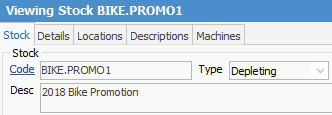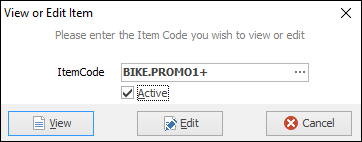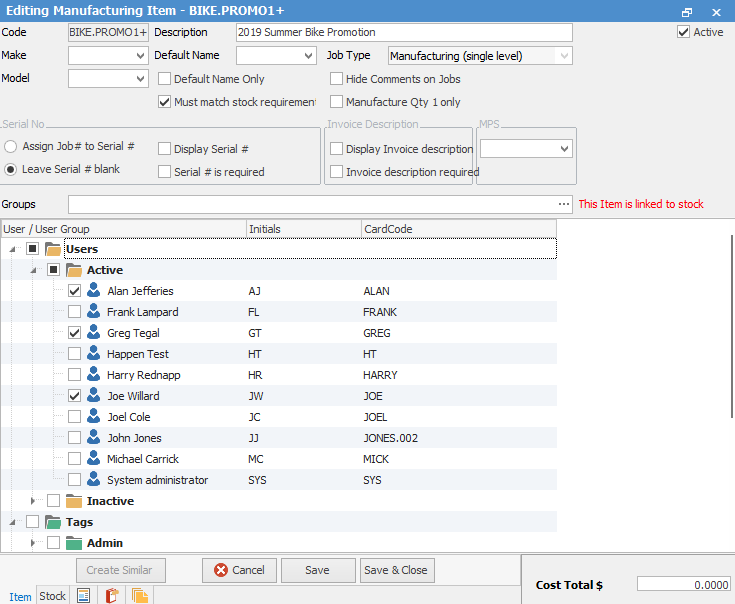
Manufactured Stock is stock that your business makes for itself, ie. fabricates from the ground up, assembles from purchased components, creates by other methods, etc. If you manufacture stock, you must first set up a part number for that stock in Jim2, then link an Item to it. You then use this Item to create the stock when you manufacture it. You can buy manufacturing stock as well as manufacture it if required.
To add a new single level Manufacturing Item, you first have to create a Manufacturing stock code. To do this, on the ribbon go to Stock > Add Stock icon.

Enter in a stock code for your desired finished product. In this example, the stock code is BIKE.WINTER.PROMO, as the intended finished product is a bicycle put together for a winter sales promotion. Select the appropriate GL Group, and also tick single level in Manufacturing and This stock This Stock I Sell. These are the minimum mandatory fields, but you may fill in others, if desired.

|
If you tick Attributes on purchase, on completion of a manufacturing job, you will need to select the attributes via the Desc. field in the Job header. See Add a Manufacturing Job for more information. |
Click Save, and confirm by clicking Yes.

Jim2 will save the stock code you entered, and because you ticked Manufacturing will also prompt you to create a new Manufacturing Item Code (this is the stock code followed by a + sign). The plus sign indicates that this is a Manufacturing Item.

Click Yes to create this Manufacturing Item.
You can jump directly to the newly created Item, by selecting the Stock Code hyperlink, as shown here.

Alternatively, choose Items > View/Edit Item from the ribbon:

If you use the second method, the View or Edit Item screen will open. Start typing the Item number, and once a suitable match is found Jim2 will fill in the rest. If the correct Item code does not appear, you can select the ellipsis [...] to open the Stock Select screen, and choose the Item code from there.
Whichever method you use to select the stock code, once the correct one is shown in the ItemCode field, click View or Edit, as required.

While in edit mode, you may enter the Make and Model of your manufactured product, as well as the default name of the person authorised to make this particular product, if you wish. For example, you may want to hand this task to someone specific, eg. to a team leader, or to someone who has received special training. You should tick Default Name Only, if you want only that person to be able to work on this product. You may also choose how you would like to deal with serial numbers (if they apply), and if you want invoices to display descriptions.

Also shown are two fields specific to manufacturing Items:
▪Must Match Stock Requirements, which means that you cannot start manufacturing until you have all of the stock that is needed for this manufacturing Item. If you want to restrict users from changing the material(s) or the quantities used to manufacture the manufacture stock, edit the linked manufacturing Item then tick Must match stock requirements.
▪Manufacture Qty 1 Only, means that you can manufacture only one unit per manufacturing job.
In the footer of the form, you will see two tabs relating specifically to this manufacturing Item, the Item tab and the Stock tab.
The Item tab will show a list of all users from your card files. You can place a tick next to the names of those you want to specify as being able to manufacture this Item, unless you have ticked Default Name Only (in the header), in which case only your default user will be selectable.

Once you have decided which users to assign to making this Item, you will need to add some stock.
To add stock, switch to the Stock tab.
By editing each line, you can add the required stock codes and quantities that make up this manufacturing Item. You may also add Applied Stock.

Click Save.
|
The order of stock added to a manufacturing job is the same order as it is on the manufacturing Item. |
Now that you've set up this manufacturing Item, you will need to put some pieces into stock. However, you don't have to Create A Manufacturing Job at this time, if you don't want to. You may prefer to wait until you've actually received an order.
|
If you mark manufacturing stock as Inactive you will be prompted to set the linked manufacturing Item to Inactive as well, if you wish. |
Further information:
Include Labour in Cost When Manufacturing
